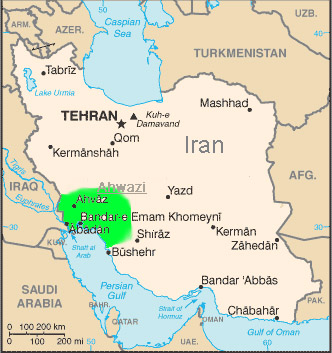Al-Aḥwaz: A Forgotten Issue Regionally and Internationally

The southwest province of ethnically Persian-dominated Iran is home to a significant Arab minority population, in an area known as al-Aḥwaz. Since its incorporation into Iran in 1926, this community has undergone oppression and discrimination from the Persian Iranian government and authorities.
The occupation of the Aḥwazi territory has resulted in the violation of human rights and what might be considered ethnic cleansing of the Arab population.
The Aḥwazi people have faced racial discrimination and marginalization, as the subject of Iran’s “persianization policies.” Like other cases of occupation, such as Western Sahara and Palestine, the Iranian government in al-Aḥwazhas been pushing out the Arab population and replacing it with “loyal Persians,” in order to ensure Persian demographic domination the region.
“Persianization” has also included changing the indigenous Arab names of villages and cities, banning the use of the Arabic language in schools, and even prohibiting parents from giving their children Arabic names. Home demolitions also have been a continued policy and practice violating the Ahwazi people’s economic, social and cultural rights.
This past June and July, the HIC-HLRN Violation Database (VDB) documented violations of home demolitions in the al-Zāwiya neighborhood of Aḥwazcity after the authorities arrested owners and changed the names of several villages from Arabic to Persian, and building new settlements for non-Arab residents, in order to change the demographic character of the region.
The region’s indigenous population also has been deprived of access to natural resource, as well as services, infrastructure and development planning. Among the methods used to foreclose local natural resources to the Arab Aḥwazi population has been through the building of dams and diverting the course of rivers to the Iranian provinces. This development pattern has resulted in the desiccation of the region’s estuaries, including the Karūn River and its tributaries, damaging local agriculture by preventing needed irrigation and increasing the salinity of rivers and streams. A Lack of water resources prevents the Ahwazi farmers from cultivating, giving the Iranian authorities a pretext to confiscate the land as fallow.
In April 2011, the Ahwaz region witnessed a series of massive protests, inspired by the Arab Spring revolutions. The Iranian authorities responded in a manner similar to the repressive governments of the MENA region, using live rounds and excessive tear gas on protesters, judicial executions, mass arrests and torture. For more information on the Aḥwazi protests, which began with a local intifadha in 2005, see the report published by the Aḥwazi Solidarity Network.
These violations against the Arabs in Aḥwaz have received little attention from the international media and international civil bodies specialized in economic and social issues. Human rights organizations are need to pay specific attention to the human rights to housing, water and land rights violations and food security in al-Aḥwaz, as well as give greater coverage to forces disappearances, extra-judicial killings and arbitrary detention against ESC rights defenders there.
For more information on the human rights violations of the Iranian government, please see the Forum on Minority Issues and HLRN report of Land Forum III.
|